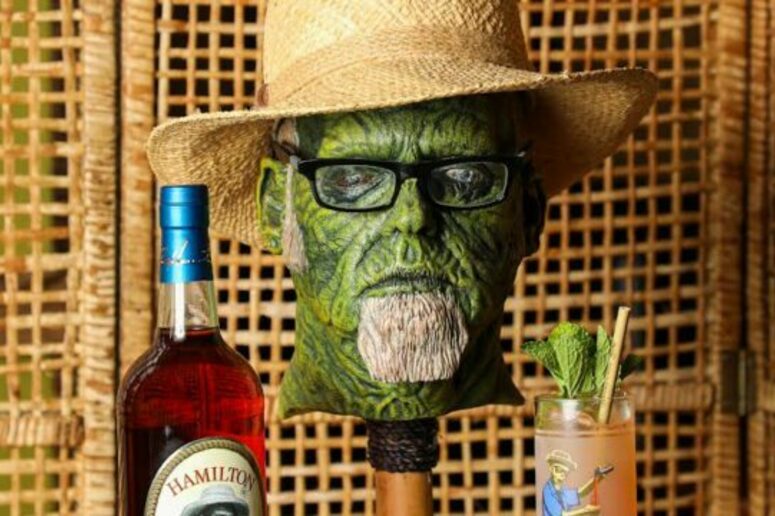Dram of the Dead : The Bum on His New Zombie Rum

On January 12, 2022 a livestream event organized by “The Rum Lab” was held at ZAVVY with the participation of Fede J. Hernandez, an entrepreneur specialized in sales and marketing, and the participation of Jeff “Beachbum” Berry who will tell us about his involvement in the world of tropical drinks and about his product “Zombie Rum“.
Jeff Berry’s Origins in the World of Tropical Beverages
Jeff began drinking tropical cocktails in 1980, when he reached the legal drinking age. At that time, he met a bar called Tiki Tiki in Los Angeles that revealed to him a universe of flavors and aromas that contrasted with the decadence of the cocktail culture of the time. The only exception, in his opinion, were tropical cocktails, which we now call Tiki, which were prepared by hand and with natural ingredients. These drinks did not yet have that name at that time.
Berry was not a professional bartender, nor did he have any aspirations to open a restaurant. He had worked in the hospitality industry, in kitchens, and had had enough of that. He was a writer and filmmaker, and for him, these drinks were simply his favorite way to relax at the end of the day. However, he was becoming more and more involved in that world every day, and in addition, the bars that served these Tiki drinks were disappearing day by day.
The Lost Recipes of Tiki Cocktails
Jeff Berry became an enthusiast of tiki cocktails. However, the cost of these drinks was high, so he began researching different recipes. He soon realized that the best recipes had never been published, as they were trade secrets. This discovery led Berry to devote his time to researching and recovering the original recipes for tiki cocktails. After spending many years working on this project, he published a book on the recipes he had found, which marked the beginning of the tiki bar renaissance.
Today, tiki bars are open all over the world, and many of them serve the drinks Berry found and published. The original “Zombi,” which was a complete mystery for many years, is one of the most popular cocktails in these bars. Berry has also published other books on tiki cocktails, and has developed a cocktail recipe app with Martin Duda and his wife. His work has helped make tiki cocktails more accessible and popular than ever.
Jeff Berry’s First Book
The first book that Jeff wrote was “The Grog Log” this book was originally a photocopied, staple-bound zine that Jeff Berry distributed at luaus and music events. He also sold it at hipster stores on Melrose. A comic book publisher in San Jose, California, called Slave Labor Graphics, took an interest in the book and suggested Berry turn it into a real book. The published version came out in 1998 and could only be found in comic book stores, as that was the only distribution Slave Labor had.
The two best-selling titles that financed the Grog Log were “Johnny the Homicidal Maniac” and “Milk and Cheese”. After “the Grog Log”, Berry and Slave Labor Graphics published two more books, Intoxica and Taboo Table. The fourth book, Sippin’ Safari, was the first book to be published with an actual binding and could be found on bookstore shelves. This book was the one that really changed things for Berry and led him to devote himself entirely to cocktails, giving seminars and publishing books.
The Tiki Cocktail Renaissance
At first, no one paid much attention to Jeff interest in tiki cocktails. He only made them for their friends in Los Angeles and thought that maybe twenty people would appreciate them. At that time, there was no real tiki cocktail revival, just a tiki pop culture revival. Jeff friend Sven Kirsten was leading that movement, along with Otto von Stroheim, another old friend, and people like Bosko, who were recovering the lost art of tiki mugs and carvings. All of this was a kind of underground alternative scene.
Tiki culture was one of the many things that revived in the 1990s, along with hot rods, rockabilly, swing and others. Gradually, it became a subculture of a subculture. At that time, Jeff met people like Sven Kirsten, author of “Book of Tiki”, who helped push the resurgence and popularized it. He also met Otto, who organized events such as luaus and music events, and eventually turned it all into a large convention called “Tiki Oasis” and Bosko who also started selling his tiki products.
They were all a group of enthusiasts interested in this lost suburban pop culture that had disappeared in the 1960s. They would go to thrift stores looking for shirts, music, mugs, furniture and everything else that was part of this Polynesian pop era. However, one important element was missing: Tiki drink recipes. Since no one had published them, Jeff Berry focused on this aspect and started publishing booklets with Tiki cocktail recipes.
At first, these booklets were not very successful, as craft cocktail enthusiasts, who were booming at the time, despised tiki. However, Jeff continued to publish his booklets and, little by little, people began to take an interest in them. Bartenders began experimenting with tiki cocktails, and berry began teaching classes on tiki history and culture.
Trader Vic’s Influence on Tiki Culture
Jeff mentions that the book “Trader Vic’s Bar Guide”, published in 1972, was the only book that gave him any hints on how to make tiki cocktails in the 1980s. This book revealed all of Trader Vic’s secrets, unlike Don the Beachcomber and others, who kept their recipes close to their chest.
In the 1980s, Jeff douna pre-blended “mighty rum” in liquor stores and supermarkets. This rum was not a cocktail, but rather a blend of rums used to make tiki cocktails. Jeff recalls that the mixture contained rum from Martinique, dark rum from Jamaica and a little rum from the Virgin Islands. Berry tried the premixed rum and liked it a lot. He believes it was a convenient way to make tiki cocktails, since he didn’t have to search for agricultural rum, which was hard to find in the ’80s and ’90s.
Trader Vic’s Rum Blends: A History and Revival
Trader Vic also had a Navy Grog rum. It was a blend of the three rums that typically go into Navy Grog: Demerara, Jamaican, and a white Spanish-style or Puerto Rican rum. Jeff found it to be delicious, both on its own and in cocktails.
These rums went out of circulation around the early 1990s. After tiki cocktails began to make a comeback in 2008-2009, various people approached to Jeff asking if he wanted to put his name on a rum blend. However, he was not interested in simply taking credit for someone else’s work.
Instead, he began to think about bringing back Trader Vic’s rum combinations. He realized that no one he knew had the ability to do this, as distilleries typically focus on making rum from a single region. It would require a distillery with the portfolio to blend rums from different regions into a pre-bottled rum blend.
The “Zombie Rum” Product
Jeff and Ed Hamilton, who owns the Hamilton Rum label, were discussing what was missing from the market for tiki cocktails. Berry suggested a zombie blend, as this would be convenient and consistent for bartenders and consumers alike. Ed Hamilton agreed to create a zombie blend, using rums from his portfolio.
Jeff Berry and Ed Hamilton discussed the benefits of a zombie blend at length. They concluded that it would be viable for three reasons:
- Cost: A zombie blend would be more cost-effective than purchasing the three individual rums required to make a classic zombie cocktail.
- Convenience: A zombie blend would be more convenient for bartenders and consumers, as they would only need to purchase and store one bottle of rum.
- Consistency: A zombie blend would ensure that bartenders are always using the same rums to make zombie cocktails, which would lead to more consistent results.
The Cost, Convenience, and Consistency of the Zombie Blend
The cost of the zombie blend is a major factor in its appeal. Ed Hamilton provided Jeff with very high proof, undiluted base rums, which allowed him to create a high ABV version of the drink that requires only two ounces of rum instead of the four ounces of three different rums called for in the original recipe by Don the Beachcomber. This saves money and is more convenient for consumers, as they do not need to purchase and store three different bottles of rum. Additionally, the zombie blend is consistent, meaning that bartenders will always get the same tasting rum base, regardless of which brand is available.
The convenience of the zombie blend is another major factor in its appeal. It is convenient for consumers, who do not need to drive to multiple liquor stores to find the three different rums required for a zombie cocktail. It is also convenient for bar owners, as many states have laws that prohibit the marriage of different spirits together. This means that bar owners in these states would otherwise need to pour and measure three different bottles of rum for each zombie cocktail, which can be time-consuming and inconvenient for customers.
Jeff and Ed Hamilton collaborated on the zombie blend rum for almost two years, carefully blending many different rums to create the perfect flavor profile. The high ABV of the rums made the blending process challenging, but he was grateful for Ed Hamilton’s expertise and guidance.
The Zombie Cocktail Ingredients
Jeff had spent many years researching the zombie cocktail, and he discovered that the secret was in the combination of three different rums: An overproof Demerara, an aged dark Jamaican, and a Puerto Rican or “Trinidad”. Jeff also learned that the modern Puerto Rican white rums were not the same as the ones used by Don the Beachcomber, the original creator of the zombie.
Jeff experimented with three different sweeteners: cinnamon syrup, pomegranate syrup or grenadine, and falernum, a compound syrup with various flavors such as ginger, almond, clove, and lime. He also added two different citrus juices: lime and grapefruit. To finish the drink, he sprinkled a dash of absinthe or herbsaint and some Angostura bitters. The result was a drink with nine ingredients that balanced each other perfectly.
The Rediscover the Original Zombie Recipe
Jeff Berry had always been curious about the zombie cocktail, which had many variations but none of them satisfied him. Jeff had assumed that the drink was only popular because of its high alcohol content. He had never tasted a good zombie, until he got a lucky break. A woman named Jennifer Santiago contacted him through Otto von Stroheim, who ran a Tiki News website. Jennifer’s father, Richard Santiago, had been a maitre d’ at Don the Beachcomber, the original creator of the zombie, in the late 1930s. He had left behind a recipe book that he had kept in his shirt pocket while working, containing many of Don’s secret formulas. Jennifer asked Otto if anyone would be interested in the book, and Otto passed the message to him. He was thrilled to receive the book, and decided to write Sippin Safari based on it.
He discovered many game-changing recipes that he had wondered about for years. However, he also faced a new challenge: deciphering Don’s code words for some of the ingredients, such as spices number two or number four, Don’s number eight, Gardenia mix, or Marquesa. He had no idea what they meant, and it took him years to figure them out. He was fortunate enough to be in Los Angeles in the early 2000s, when some of the old-timers who had worked at tiki bars were still around. They had moved on to other jobs, since most of the tiki bars had closed down.
The Upscale Transformation of Tiki Culture
Robert Hess, a spirits writer, explains that Tiki bars became popular. The drinks served at Tiki bars were an entirely new style of mixology after prohibition in the 1930s. However, the atmosphere was also very important. Tiki bars provided a little mini vacation for people who could not afford to go anywhere during the depression. For the price of a drink, people could have a little mini tropical vacation and buy themselves a stool, which was real estate in this little tropical fantasy. The whole Polynesian themed bar and restaurant craze started in the middle of the depression. After World War II, people were even more freaked out and bummed out. The refuge of Tiki Bar in the 1950s provided an escape for people who were completely paranoid that any day they’d wake up and hear the air raid sirens go off and nuclear winter would ensue. So basically, Tiki was lucky in that the worse things got in the news, the better it was for Tiki. Everybody needed that refuge and escape.
In the 1950s, Tiki culture was already in its third decade of popularity when Trader Vic partnered with the Hilton chain to establish Trader Vic’s in Hilton restaurants worldwide. Recognizing the profitability and potential to draw guests, Hilton eagerly embraced this venture. This partnership resulted in the establishment of 14 to 21 Trader Vic’s restaurants globally. Other hotel chains followed suit. The Sheraton chain collaborated with Steve Crane from the Luau restaurants to launch Kon-Tiki ports, which were equivalent to Trader Vic’s in Sheraton Hotels. The Marriott chain also had a similar establishment, though the name is currently not recalled.
Rum’s Rising Popularity
Jeff expresses hope that rum will continue to gain momentum and take its rightful place as a base spirit in the cocktail world. This isn’t limited to tropical bars but extends to all types of establishments, including craft and sports bars. He believes that rum cocktails should be a significant part of any bar’s offerings and also hopes that the zombie blend will contribute to the work being done by rum evangelists like Ian Burrell and others. The aim is to showcase the vast spectrum of flavors and expressions that rum offers. The speaker highlights the unique ability to mix three different rums together to create a base spirit for a single drink, something not commonly done with other spirits.
The complexity of rum, with its varying densities, flavors, terroir, distillation, and blending methods, used to deter people. However, Jeff notes a shift in perception. More people are becoming intrigued by rum’s complexity and are eager to explore its vast spectrum, he has observed an increasing number of spirits aficionados transitioning from whiskey to rum due to its depth and variety. The exploration of rum offers an exciting journey for these enthusiasts as they seek to understand the category and find their preferred expression from their favorite island.
The New “Navy Grog” Rum
Jeff Berry mention that he is excited about his next collaboration with Hamilton, which is a Navy Grog rum. This inspiration came from Vic, who had done something similar many years ago. The Navy Grog has always been Jeff’s go-to drink at Trader Vic’s, and any other place that served them. He is thrilled to be able to create this grog rum with Ed Hamilton.
Jeff appreciates Ed’s extensive portfolio, which allows them to create this unique blend. The process of creating the Navy Grog rum involved a lot of trial and error. The goal for the Navy Grog rum is to blend three different rums together so that the cocktail can be made with just one bottle of rum. Jeff emphasizes the importance of consistency, especially when it can be challenging to get the preferred brand of Demerara or the right Jamaican rum. This new blend is their solution to these challenges.
The Unresolved Mystery in the World of Mixology
Jeff Berry, having devoted a significant portion of his life to researching and publishing historical drinks, still sees a future filled with unexplored territories. One such area of interest lies in the realm of Don the Beachcomber drinks. About 20 of these drinks were introduced in Hawaii when Don the Beachcomber opened a venue there in 1948. However, Berry has yet to discover what these drinks are, as he has not come across a recipe book that includes them. This mystery represents a sort of “Holy Grail” for him, fueling his ongoing quest for knowledge in the field of mixology. Berry remains optimistic about the possibility of uncovering these unknowns, acknowledging that one never knows who might reach out with new information or who one might encounter in this fascinating journey.












